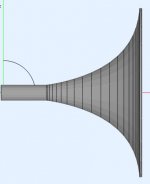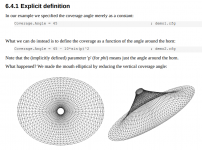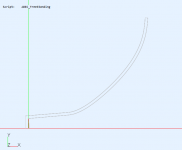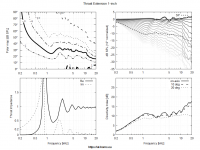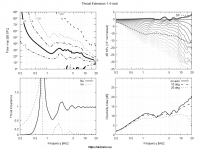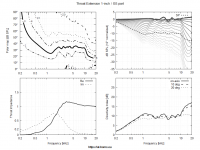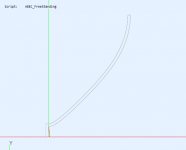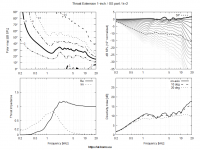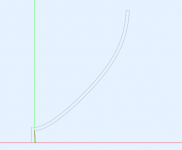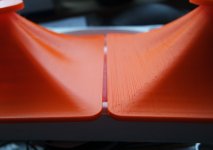500Hz? That probably makes you the record holder 😉
I have never come across anyone who used a BMS 455.. so low, and definitely not with a shallow waveguide.
The red horn should load the driver extremely well. What is the length (throat to mouth)?
My 4554s didn't sound right < 700 Hz, even at low SPL. I changed one of the diaphragms, but it didn't make a difference.
Perhaps the throat size matters.
I have never come across anyone who used a BMS 455.. so low, and definitely not with a shallow waveguide.
The red horn should load the driver extremely well. What is the length (throat to mouth)?
My 4554s didn't sound right < 700 Hz, even at low SPL. I changed one of the diaphragms, but it didn't make a difference.
Perhaps the throat size matters.
Last edited:
Once the walls are flat the length is irrelevant, so the only part that "loads" the driver any more than a typical OS waveguide is the first 1/4 or so...
Honestly I wouldn't expect very high loading - the more I'm curious to see the sims (and measurements of course).
Honestly I wouldn't expect very high loading - the more I'm curious to see the sims (and measurements of course).
Last edited:
Even though it doesn't look like there's an expo, or similar type of profile involved, the small cross-sectional area of the "extended throat" does restrict the passage of air and should present a fairly high acoustic impedance to the driver. It may therefore very well approach an exponential expansion rate.
Besides, there's a transition from round - at the entrance - to an ellipse, so there aren't any parallel sides.
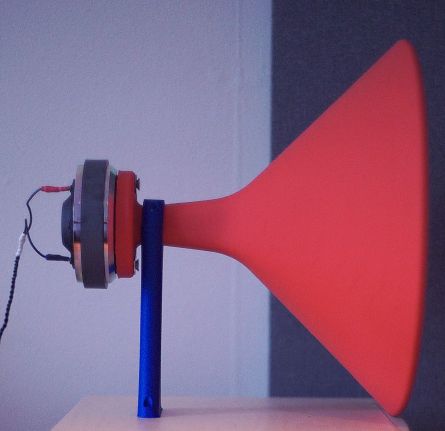
Besides, there's a transition from round - at the entrance - to an ellipse, so there aren't any parallel sides.
Last edited:
error c0000020
This is the "bad exe format" error, which suggests that your Wine installation is not set up to run 64-bit programs.
Last edited:
Once the walls are flat the length is irrelevant, so the only part that "loads" the driver any more than a typical OS waveguide is the first 1/4 or so...
Honestly I wouldn't expect very high loading - the more I'm curious to see the sims (and measurements of course).
It's exactly the first part of any horn that - to the utmost extent - determines loading characteristics.
I suspect the cutoff of aragorus' horn is at least twice as low as that of an OS waveguide of the same size as the mouth of the red horn
Plastic annular diaphragms in particular seem to be sensitive to loading.
Last edited:
Ro808, mind that the external contour is not identical to the internal.
That's what I suspected, if only because of the transition 😉
It's also clear that we shouldn't expect a stellar DI, but (probably) an acceptable compromise.
Last edited:
I'm using an elliptical throat angle defined in this style
"Throat.Angle = 14 - 10*sin(p)^2"
I'm sorry, I'm not following that equation. What is "p" and what is "Throat.Angle". What do these represent?
What is "p" and what is "Throat.Angle". What do these represent?
It is the equivalent of this example for coverage in the manual but applied to the throat angle parameter
Attachments
Again, size of the mouth doesn't affect throat impedance of an OS waveguide (20cm or 200cm, it will be the same for the same nominal coverage). The same holds for the conical throat extension used above - it's the angle that counts, not the length. The length will affect manifestation of the reflection that's gonna likely happen at the interface....I suspect the cutoff of aragorus' horn is at least twice as low as that of an OS waveguide of the same size as the mouth of the red horn.
Last edited:
You are right. I changed the handling of this to easily and more intuitively model the conical extensions of the drivers, which are always circular. And now I see the parameter 'Throat.Ext.Angle' is taken as constant as well. I will allow this to be a function of 'p' in the next release so you should be able to create the same shape as before.It seems like the newest version doesn't take the throat angle into account when extending the throat 🙁
View attachment 924028
This is what I get for an axisymmetric shape. The throat impedance is indeed increased below 1 kHz by the means of the resonance. Is this a good idea? Maybe, I don't know.
Now the question is whether and how much can an elliptical shape improve this. Maybe it can.
Now the question is whether and how much can an elliptical shape improve this. Maybe it can.
Attachments
This is the "bad exe format" error, which suggests that your Wine installation is not set up to run 64-bit programs.
That is probably correct - thanks, very helpful!
//
All compression drivers use resonance to increase efficiency in the passband (on the lower end), for example. It's not always bad.
This is the "OS" part alone for the 1" case -
Attachments
Last edited:
Thanks for the tip - PrusaSlicer is a considerable improvement (without any further tweaking).... I had the best results with PrusaSlicer and Slic3r being second best. I was not able to make good quality in Cura.

Attachments
- Home
- Loudspeakers
- Multi-Way
- Acoustic Horn Design – The Easy Way (Ath4)
